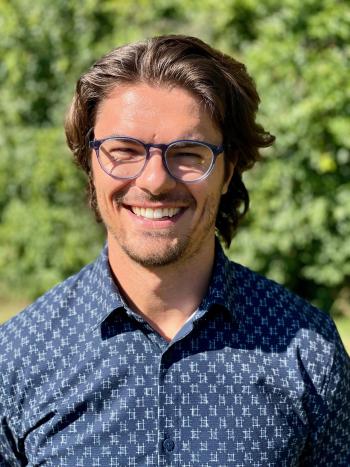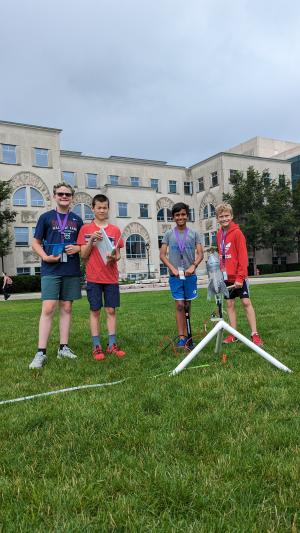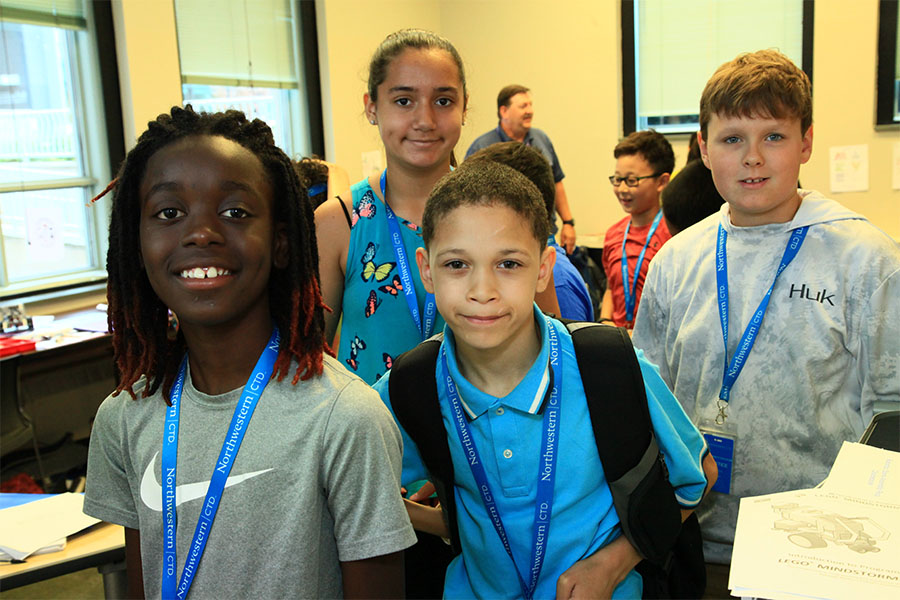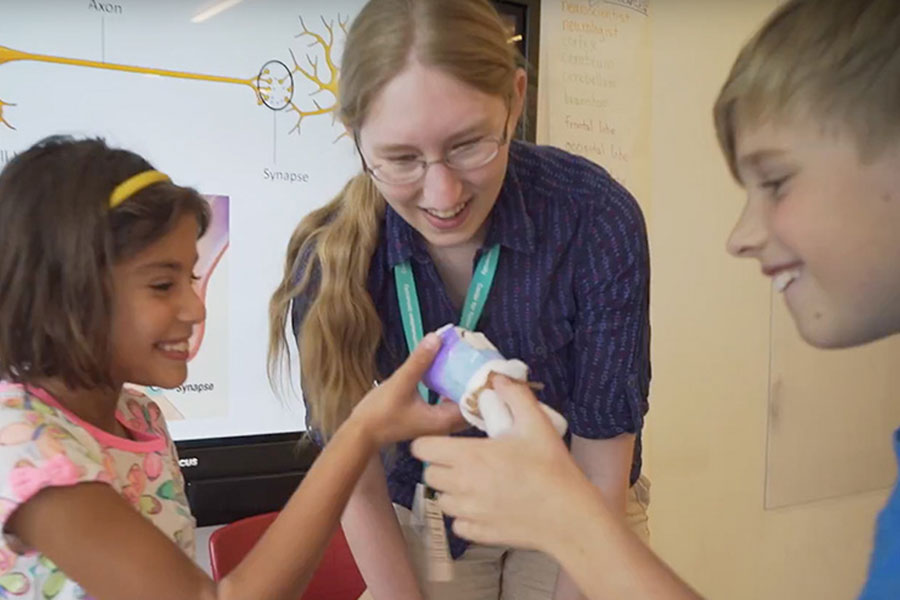Aerospace Engineering Course Ignites Love of Science, Learning
By Ed Finkel
The final project in the “Aerospace Engineering” course that Ryan Christopoulos has taught at CTD since 2012 involves designing and building a working water rocket from scratch, using a one- or two-liter bottle and other materials students obtain, based on a certain budget. During the school year, when he’s an eighth-grade and gifted science teacher at Robert Frost Junior High in Schaumburg, Illinois, if Christopoulos were to assign such a project, it would take students three or more weeks to complete in increments of probably 30 minutes at a time.
 But at CTD, those kids can build and test a rocket all within the same day, Christopoulos says. “And then take that knowledge and go through the iterative engineering process, and come back to it, and really dive into it,” he says, given the five-hour class periods that CTD summer sessions afford. “That’s one thing that keeps me coming back to [CTD] after doing it for so long now, is just getting the chance to give kids the opportunity to really sink their teeth into something and wrestle with a problem for an extended period of time.”
But at CTD, those kids can build and test a rocket all within the same day, Christopoulos says. “And then take that knowledge and go through the iterative engineering process, and come back to it, and really dive into it,” he says, given the five-hour class periods that CTD summer sessions afford. “That’s one thing that keeps me coming back to [CTD] after doing it for so long now, is just getting the chance to give kids the opportunity to really sink their teeth into something and wrestle with a problem for an extended period of time.”
Overall Christopoulos, who received his master’s degree in education from Northwestern in 2016, feels like he cross-pollinates his teaching style and substance back and forth between Robert Frost and his summer gig. “I was doing a lot of hands-on stuff in my home school. And then when I came to CTD, that first year trying to figure things out,” he says. “And then learning how to navigate and how to manage a class where you’ve got kids making messes. Science gets a little messy. How do you manage that in space and keep it organized? I bring that back to my class during the school year, and vice versa.”
Christopoulos also draws upon his own science education, during which “I was very fortunate to have a lot of science teachers that promoted hands-on, actual inquiry science,” he says. “The only way you’re going to get good at science is by actually doing science: by manipulating things, by trying things, by figuring out what works and what doesn’t work, by asking questions, by being stumped by things sometimes, and then trying to figure out why you’re stumped. For me, it always goes back to, ‘How can I get the kids to engage in questions? How can I get them to engage in inquiry? And how can I do that in a way that’s concrete?’ ”
During his master’s degree program, Christopoulos worked with Professor Brian Reiser and adjunct instructor Michael Novak, whose work is steeped in inquiry-based and hands-on science. “Getting to learn from them, and getting better at questioning, and not just giving the answer—but rather creating a series of experiences and asking the right questions to let kids discover, and see a lot of the stuff on their own—that’s really been my focus, both during the school year and at CTD,” he says.
 Teaching aerospace engineering to middle-school-aged children is not without its challenges, Christopoulos notes. For one thing, “it’s tough to find a textbook that covers the foundations of aerospace engineering at a reading level that’s appropriate for this group, even being a gifted class,” he says. The textbook he uses covers aspects like Newton’s laws, and wing shape and design, and how airfoil creates and promotes lift. “We talk about helicopters. We talk about rockets,” he says. “We give the kids a pretty good foundational knowledge on lot of different aerospace topics. Then, within the activities that they’re doing, they’re challenged to try to apply those concepts in some way.”
Teaching aerospace engineering to middle-school-aged children is not without its challenges, Christopoulos notes. For one thing, “it’s tough to find a textbook that covers the foundations of aerospace engineering at a reading level that’s appropriate for this group, even being a gifted class,” he says. The textbook he uses covers aspects like Newton’s laws, and wing shape and design, and how airfoil creates and promotes lift. “We talk about helicopters. We talk about rockets,” he says. “We give the kids a pretty good foundational knowledge on lot of different aerospace topics. Then, within the activities that they’re doing, they’re challenged to try to apply those concepts in some way.”
The course also bolsters critical thinking skills, Christopoulos says. “The content lends itself to the kids critically thinking about, ‘How can I take these foundational physics concepts like Newton’s laws, and apply it to things that fly in the air?’ ” he says. “The other critical thinking aspect is in a lot of these hands-on [processes] too because there’s time involved. They can go through that iterative design process.”
Students start projects with a hypothesis of how they want their design to work, or how they think it’s going to work—and then “build it, test it, observe it, modify it, come back, test it again, over and over, over a repeated time,” Christopoulos says. “And then through small, incremental changes, they’re able to improve that design’s performance and able to take some of the technical knowledge that we’ve learned from our homework, or from our lecture, and try to apply that to the best of their ability.”
In three weeks, Christopoulos says he sees an impressive amount of growth in the students—and he emphasizes that his role is to facilitate those experiences. “I don’t want to come across as somebody that is, like, the Willy Wonka of aerospace,” he says. “I’m creating an opportunity for kids to engage in something, but because of the types of kids we have, and the motivation that they have—they do it all. It’s very much me saying, ‘Here’s what we’re going to work on, here’s the parameters, here’s the limitations. Here’s the box we’re working within. You have freedom within that box to build and create whatever you want in there.’ My job is to guide and ask questions, ‘Hey, have you thought about this? … How can we make it better?’ ”
Too often, gifted education amounts to giving students more hoops to jump through—rather than more space and time to dive deeply into something that fascinates them, Christopoulos believes. “We know that they’re accelerated, we know that they’re motivated, and they’re going to jump through those hoops,” he says. “I’ve learned to pull back and create space, create openness, create opportunity, and something cool is going to come out of that...working at CTD for all these years, teaching a class that’s structured this way, has allowed me do to that."
“It changes every year because it depends on the kids that you get,” he adds. “But we always manage to land the plane in some way, shape or form.”

